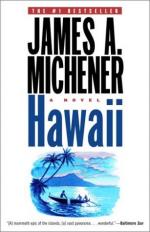|
This section contains 485 words (approx. 2 pages at 400 words per page) |

|
Hawaii Summary & Study Guide Description
Hawaii Summary & Study Guide includes comprehensive information and analysis to help you understand the book. This study guide contains the following sections:
This detailed literature summary also contains Related Titles and a Free Quiz on Hawaii by James A. Michener.
Hawaii, by James Michener, is a historical novel about the Pacific and the Hawaiian Islands. It begins with the islands' formation from volcanic activity and then describes the history of the people, the original Polynesians. The book describes the missionaries who brought religion to the people and discusses the intermarriages with the Chinese, Japanese, and Filipinos. It tells their story—how they struggled, who their kings and queens were, and how they existed.
The book tells the fascinating story of how the islands developed; how eleven missionary families arrived in Hawaii and, over the generations, became the backbone of its government and society in addition to becoming very wealthy and active in business and commerce. The original missionary families, in addition to trying to convert the pagans, taught the population to read and write and Western customs. As time went on, each succeeding generation became more of a blend of the eastern and western culture that existed in Hawaii.
Michener looks at the different ethnic groups and how they came to be there. The original group fled from Bora Bora. This formed the royalty of the island. Then the missionaries came. The influx of Chinese was exemplified by Mun Ki and Wu Chow's Auntie's family. The Japanese were exemplified by Kamejiro Sagawa's family. Michener leads the reader through the establishment of these families as members of the community and shows how each of them contributed to the development of the islands. The novel also shows how each of them dealt with changes. Michener uses historical facts to develop the story of his novel.
The novel beings in the ninth century and ends in the mid 1950s. The novel shows how the descendants of the original missionaries became the leading families in terms of business, wealth, and politics. The many intermarriages resulted in all of the originals becoming known as the family. Some married Hawaiians. Most were sent to America to be educated. When they left the ministry they went into business on the islands. These businesses, over the years, developed into the most powerful and successful ones on the islands.
Michener served in the Pacific Theater in World War II, during which he became interested in the islands where he lived for a while. He had to do a great deal of research for his novel in order to establish the background of his characters and to develop the character and his or her role in Hawaii. The thousand page novel takes place within the historical context. The long book will hold the reader's interest. The book is well written and shows the depth of the author's research. The first chapter is one of the most beautifully written chapters in literature, as it tells the story of how islands are created over millions and millions of years. The book is well worth the time that is required to read it.
Read more from the Study Guide
|
This section contains 485 words (approx. 2 pages at 400 words per page) |

|



